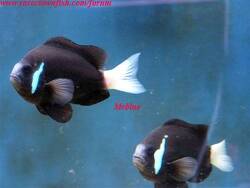Info
Amphiprion mccullochi, Whitley, 1929
According to FishBase associated with Entacmaea quadricolor, in the book by Gerald R. Allen there is also a reference to Radianthus crispa.
Rarely found in the trade, often only available from private breeders, and will remain an eternal rarity.
Sex and mating.
Anemonefish are protandrous hermaphrodites, meaning that life begins as a male. If two juveniles of the same size are present, then the more dominant anemonefish will develop into a female. If two females of the same size are placed together, then the weaker female will form back into the male, but this will take some time and there will be fierce fighting. The reversion can take several weeks, and during this time the more dominant female will keep putting the pressure on the weaker female until the sex has changed.
If there are several anemonefish in the aquarium and the dominant female dies, the previously dominant male will revert to female and a previously suppressed animal will move up to the dominant male. By this adjustment the main task, the spreading of the "own genes" on fast way remains.
Once the disputes have settled and the roles are established, the female will continue to grow. The difference in size from male to female is about 1-3 cm depending on the initial size of the species.
There is currently (2007) one breeder who breeds animals in Australia.
The young animals are offered for approx. 200 euros (1/2023) in Germany.
According to FishBase associated with Entacmaea quadricolor, in the book by Gerald R. Allen there is also a reference to Radianthus crispa.
Rarely found in the trade, often only available from private breeders, and will remain an eternal rarity.
Sex and mating.
Anemonefish are protandrous hermaphrodites, meaning that life begins as a male. If two juveniles of the same size are present, then the more dominant anemonefish will develop into a female. If two females of the same size are placed together, then the weaker female will form back into the male, but this will take some time and there will be fierce fighting. The reversion can take several weeks, and during this time the more dominant female will keep putting the pressure on the weaker female until the sex has changed.
If there are several anemonefish in the aquarium and the dominant female dies, the previously dominant male will revert to female and a previously suppressed animal will move up to the dominant male. By this adjustment the main task, the spreading of the "own genes" on fast way remains.
Once the disputes have settled and the roles are established, the female will continue to grow. The difference in size from male to female is about 1-3 cm depending on the initial size of the species.
There is currently (2007) one breeder who breeds animals in Australia.
The young animals are offered for approx. 200 euros (1/2023) in Germany.







 MT-Aquaristik
MT-Aquaristik




























































